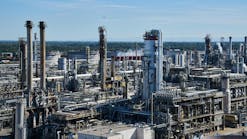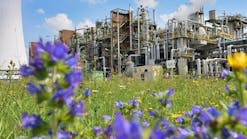ExxonMobil commissions Beaumont refinery expansion
ExxonMobil Corp. has started up its long-planned project to expand light crude oil processing capacity by 250,000 b/d at ExxonMobil Product Solutions Co.’s integrated refining and petrochemicals complex along the US Gulf Coast in Beaumont, Tex. (OGJ Online, July 29, 2022).
Officially in operation as of Mar. 16, the $2-billion Beaumont expansion—completed on time and within budget despite difficulties posed by outbreak of the global pandemic following start of project construction in 2019—increases the refinery’s overall crude processing capacity to more than 630,000 b/d, the operator said.
Proposed in 2018 and formally approved in early 2019, the expansion added a third crude unit and hydrotreaters to accommodate the operator’s growing Permian light crude production, to which the refinery is linked via pipeline (OGJ Online, Jan. 29, 2019).
ExxonMobil said the Beaumont refinery’s new crude unit also will be well-positioned to further capitalize on segregated crude from the Permian’s Delaware basin. Delaware production will be delivered via the ExxonMobil Pipeline Co.-operated 650-mile, 36-in.Wink-to-Webster (W2W) pipeline that delivers to Webster, Baytown, and the Enterprise Crude Houston Oil terminal, in addition to providing connectivity to Texas City and Beaumont (OGJ Online, Oct. 16, 2020).
An ExxonMobil spokesperson told OGJ the Beaumont refinery also has completed connecting pipeline additions at the site to accommodate the expansion’s increased intake and offtake of crude and finished products, respectively.
“ExxonMobil maintained its commitment to the Beaumont expansion even through the lows of the pandemic, knowing consumer demand would return and new capacity would be critical in the post-pandemic economic recovery,” said Karen McKee, president of ExxonMobil Product Solutions.
“The new crude unit enables us to produce even more transportation fuels at a time when demand is surging,” McKee said, noting the recent expansion adds the equivalent capacity of a medium-sized refinery.
Technip Energies (formerly TechipFMC PLC) provided engineering, procurement, and construction (EPC) of four units added as part of the expansion—including an atmospheric pipe still, kerosine hydrotreater, diesel hydrotreater, and benzene recovery unit—while KBR Inc. delivered EPC services for the project offsites and interconnecting units (OGJ Online, Feb. 25, 2019).
Permian growth
In its earnings presentation for fourth-quarter 2022 and preliminary results for yearend 2022, ExxonMobil said it increased year-over-year net production from the Permian by about 90,000 boe/d to about 550,000-560,000 boe/d, with overall production from its regional operations anticipated to reach more than 600,000 boe/d during 2023.
By 2027, the operator said it plans to grow Permian output to about 1 million boe/d amid ongoing improvements in capital efficiency, lower costs, higher resource recovery, and better environmental performance.
ExxonMobil confirmed that by the end of fourth-quarter 2022 it had eliminated routine flaring from its Permian operations by 100% as part of the company’s efforts to achieve net-zero Scope 1 and 2 greenhouse gas (GHG) emissions from the region by 2030.

Robert Brelsford | Downstream Editor
Robert Brelsford joined Oil & Gas Journal in October 2013 as downstream technology editor after 8 years as a crude oil price and news reporter on spot crude transactions at the US Gulf Coast, West Coast, Canadian, and Latin American markets. He holds a BA (2000) in English from Rice University and an MS (2003) in education and social policy from Northwestern University.


